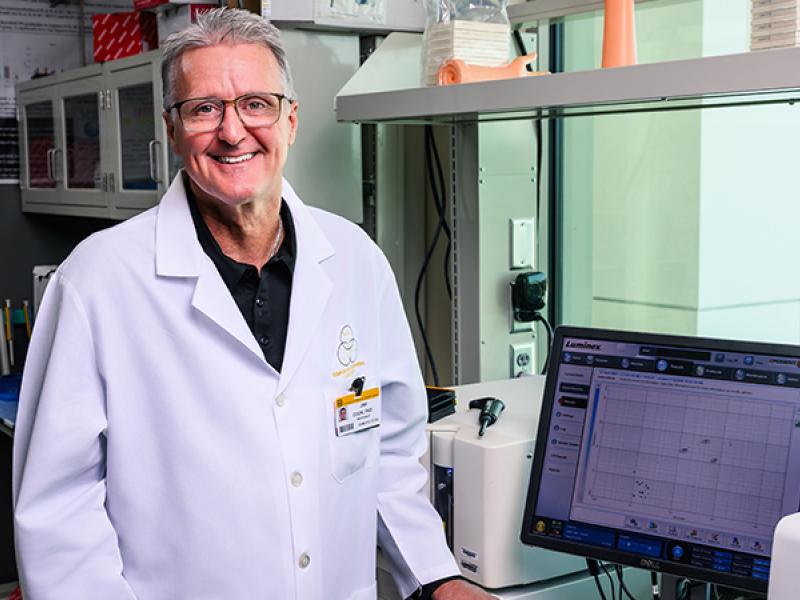
Hip dysplasia is a common problem in people and dogs. Precision medicine research at the University of Missouri could help prevent the condition from turning into painful hip arthritis.
MU researchers have developed a test to screen for hip dysplasia — a joint disorder in which the hip socket doesn’t fully cover the ball of the upper thigh bone — by measuring protein biomarkers in blood and urine. The researchers have shown these biomarkers can provide an early diagnosis of hip dysplasia in puppies. Now they are studying whether biomarkers can screen for hip dysplasia in young people, too.
If fully validated, a simple blood and urine test would catch the problem early, helping people and their pets avoid the arthritis that often leads to joint replacement surgery.

“We used to say hip arthritis was always due to aging and genetics, but we have learned that is not the case,” said James Cook, DVM, PhD, the director of MU’s Thompson Laboratory for Regenerative Orthopaedics. “Now that we look back, many older patients coming in for hip replacement for their arthritis either had hip dysplasia or FAI — femoral acetabular impingement — when they were young. With effective biomarkers, we could intervene early to tell patients, ‘If you have hip dysplasia, you are headed toward arthritis, but there are things we can do now to save your hip.’ The same is true for dogs.”
The current test for canine hip dysplasia is an X-ray taken at age 2, when the hips have fully developed. At that point, it’s too late to treat the dog with physical therapy or surgery that can prevent arthritis and there’s a chance the dog has been bred and passed on the genetic trait.
MU researchers found a potential solution through precision medicine. They tested fluid samples of 74 dogs that were at least 2 years old and had been X-rayed for hip dysplasia. They found seven biomarkers — such as proteins associated with joint inflammation and proteins linked to deteriorating cartilage — present in dogs with hip dysplasia but not in healthy dogs. They published the study in the Journal of Orthopaedic Research.
Then, they used a “reverse engineering” approach to validate the biomarkers for screening puppies. That pilot study showed blood and urine biomarkers could predict if 5-month-old puppies would get hip dysplasia.

Now, they have begun a larger study in partnership with the Orthopedic Foundation for Animals. They will test fluid samples from 500 puppies between the ages of 4 and 6 months. Based on those results, the researchers will predict which dogs will suffer from hip dysplasia. The dogs will be X-rayed at age 2 to see if the predictions were accurate on a large scale.
“That would change everything for hip dysplasia treatment in dogs worldwide,” Cook said. “And what’s cool is we’re using the same approach to attack this problem for people, too.”
Hip dysplasia causes about 20% of hip replacement surgeries in people under 50. It is the leading cause of hip replacement for women under 50, as females are four times more likely than males to have the condition. People with severe hip dysplasia are often diagnosed as newborns, but people with milder cases often aren’t diagnosed until they start feeling persistent hip pain in their late teens to early 30s.
In June 2019, researchers began analyzing blood and urine samples from consenting adult patients at MU Health Care. Through February 2020, they had collected 60 samples from patients with hip dysplasia and patients with healthy hips. They ultimately will analyze samples from 200 to 280 patients and try to isolate a panel of biomarkers that accurately diagnoses hip dysplasia in its early stages.
Surgeon Brett Crist, MD, a hip specialist at MU Health Care’s Missouri Orthopaedic Institute, said if the condition is diagnosed before arthritis develops, the patient could potentially avoid a joint replacement later in life. In patients with mild hip dysplasia who are identified early, the condition can be managed through physical therapy that strengthens the muscles supporting the hip. In more severe hip dysplasia, surgeries can correct the hip bones and decrease the need for hip replacement at an early age.
“A lot of these patients start having symptoms when they’re in the prime of their life,” Crist said. “It affects their ability to be active in sports or even do everyday activities. Then their quality of life is affected for years. So our goal is to maximize that quality of life both early in life and as they go through adulthood.”

Highlighting the promise of personalized health care and the impact of large-scale interdisciplinary collaboration, the NextGen Precision Health initiative is bringing together innovators from across the University of Missouri and the UM System’s three other research universities in pursuit of life-changing precision health advancements. It’s a collaborative effort to leverage the research strengths of Mizzou toward a better future for the health of Missourians and beyond. The Roy Blunt NextGen Precision Health building at MU anchors the overall initiative and expands collaboration between researchers, clinicians and industry partners in the state-of-the-art research facility.





